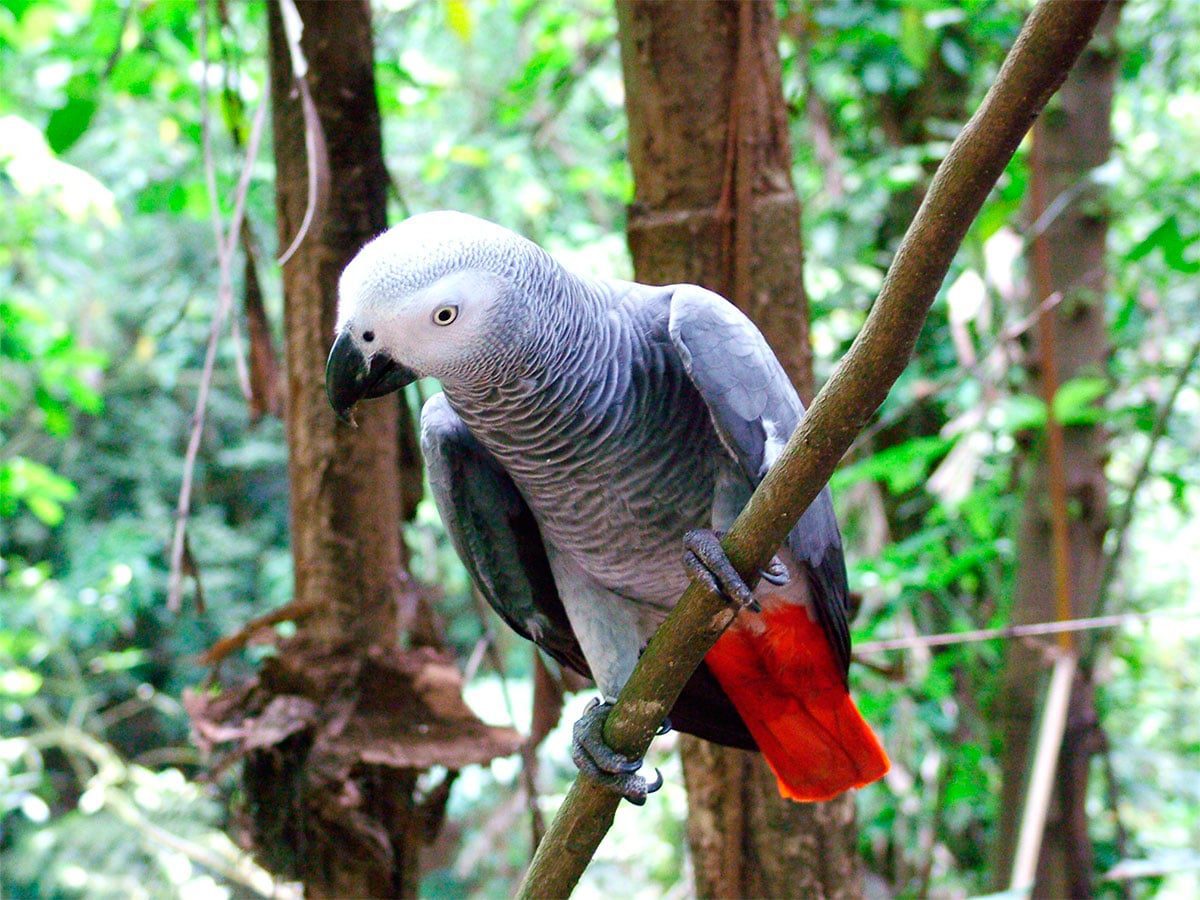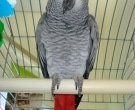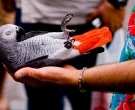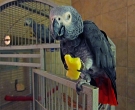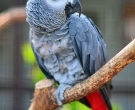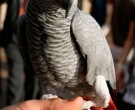Content
|
|---|
Description Loro Yaco:
Of 33 cm.. length and an average weight of 475 g..
The Grey Parrot (Psittacus erithacus) is famous for its intelligence and ability to mimic sounds and human speech, so it is one of the most popular of all pets avian. It is one of the largest parrots in Africa.
They have the feathers of the lores, the cheeks, the frenyou and the crown silver grey, more clear tips. The of the the mantle and lower area of the back darker, slate gray with light margins, giving a scaly appearance; the lower area of the back and tail are silver grey. Upper wing coverts, secondaries and scapulars slaty-grey. Primaries grey dark (almost black), more clear below that top.
Wing feathers light grey, with the exception of the greater coverts that are of a dark grey tone.
feathers of the chest slate gray with pale gray margins fused with much lighter silver feathers on the belly; flanks and the thighs clear silver grey color.
Tail and their coverts, bright Scarlet.
Older birds they can show scattered red feathers between the plumage gray, especially in the the thighs and the belly.
The bill black; irises yellow; naked facial area with some fine white hairs; legs dark grey.
Without sexual dimorphism in the plumage.
Immature they have the tail darker red towards the tip, Grey dye in undertail- coverts and the irises grey.
- Sound of the Grey Parrot.
Subspecies description:
-
(Linnaeus, 1758) – Subspecies nominal
Psittacus erithacus erithacus
-
(Alexander, 1909) – Very similar to the nominal, except that they are a little smaller. Some bird breeders argue that the Princeps is a regional type of Psittacus erithacus erithacus, instead of separate subspecies.
Psittacus erithacus princeps
Habitat:
The Grey Parrot They inhabit the tropical jungle primary and secondary, the forest edges and clearings, gallery forest and mangroves; wooded Savannah, haunting, often, land cultivation and even gardens.
Partially confined in the lowlands, Although in the East of its range have been recorded at altitudes of 2.200 m.
They reach the highest densities in primary lowland forests, intermediate in the primary montane and lower density in plantation of coconut.
gregarious, they form large communal roosts of up to 10.000 individuals, often at some distance from the feeding areas.
Preferred places of shelter are trees or palm trees on the water, also islands in the rivers.
Are dispersed into smaller groups (until 30) to feed.
Reproduction:
The reproduction of the Grey Parrot takes place in loose colonies, in which each pair occupies its own tree. Individuals select their partners carefully and have a monogamous union of lifelong It begins at sexual maturity, between three and five years of age.
Few details are known about the courtship in nature, but have been observed and recorded flights of visualization around the nest cavities. The males feed their mates (power dating) and both sing soft monotonous notes. At this time the female goes to sleep to the nest cavity, While the male takes care of it.
In captivity, the Grey Parrot fed males to females after copulation events and both sexes participate in a mating dance in tipping its wings.
The nest they build it in the cavities of some tree (for example, Terminalia, Ceiba or Distemonathus), between 10 and 30 meters above the ground.
Sometimes breeds in colonies of up to several hundred couples loose (in Prince for example), but in most places they nest alone.
Breeding season varies with locality. In East africa, breeding has been recorded in the months of January-February and June-July, both in dry periods.
Young chicks have been released for sale from March onwards in Ghana. Other records suggest as a rule from the breeder, the dry season.
The females lay from three to five eggs, that you are in charge of incubate while they are powered entirely by the male. The incubation lasts approximately thirty days and the young man emerges from the nest at twelve weeks of age.
Food Loro Yaco:
Their diet consists of a variety of seeds, nuts, fruits and berries.
Known within their power are the fruits and seeds of Ficus, heisteria, Dacryodes, Petersianthus, Combretum, Macaranga, Raffia, Her heart, Ceiba, Sapida, Bombax, Celtis, Hunting, Parkia, Terminalia and Prunus.
The fruit of the Palm oil (Elaeis guineensis) is her favourite in some areas, coming to bear its fruit over long distances before being consumed.
In Bioko, they prefer the berries of Tragacantha tail (Fam. Malvaceae).
They can be a pest, causing considerable damage to corn crops in some areas.
Loro distribution Yaco:
Size of the area of distribution (reproduction / resident): 2.760.000 km2
The Grey Parrot are distributed between the West and centre of Africa, of Guinea-Bissau and this from Sierra Leone, across the South of Mali, Ivory Coast, Ghana and Nigeria, until Cameroon, extending to Bioko and Islands Sao Tome and Principe in the gulf of guinea; from Gabon and the Congo through Zaire, Uganda and Western Kenya, the Southwest and East - Central of Zaire and Northwest of Tanzania.
Usually sedentary. Common where large extensions of forest persist and still abundant in some localities, especially in the tropical jungles of the Congo basin. But, due to the extensive loss of forests in some parts of the range (for example, of Nigeria to Sierra Leone) and the catch on a massive scale (the second best-selling parrot in the world in the Decade of 1980) There have been dramatic declines in some places (for example, in Liberia, Ghana, Kenya and around Kinshasa, Zaire, and other cities of the Congo basin).
Subspecies distribution:
-
(Linnaeus, 1758) – Species nominal
Psittacus erithacus erithacus
-
(Present on the islands of Saint Thomas (in this possibly introduced) and Principe)
Psittacus erithacus princeps
Conservation “Grey Parrot”:
• Current Red List of UICN: Vulnerable.
• Population trend: Decreasing
The Grey Parrot They are protected by the convention CITES, consisting in annex II (species that may be threatened by a trade out of control).
If it is considered not threatened globally, the fact of being one of the species of the family Psittacidae (parrots and parakeets) most sold in the world makes its distribution is shrinking dramatically in certain places, its disappearance may be close in many of these areas according to the organization The World Parrot Trust [4].
The following data are quite illustrative in this respect:
-
1. In the period 1982-1989 It was the second psittacida then suffered more trade of Agapornis fischeri, with averages of more of 47.000 specimens exported from Africa annually [1].
2. The export quotas under the CITES agreement for psittacines are often not adjusted to scientific criteria due to the lack of detailed population studies and the annual renewal rates of the populations. [2].
3. Too often these quotas are widely exceeded by exporting countries.. These may include Cameroon exported 23.000 grays in 1996, When I had a share of 12.000! [2]. Although these facts to do that Cameroon could not legally exported in 1997, the current quota of 12.000 grays is exceeded with more of 15.000 all the years [5]. Another example, is the Republic of Congo, with an annual fee of 10.000 grays, that has also been sanctioned by the impossibility of exporting them in 2001 and 2002 by the large number of existing fraudulent export [6].
4. In the year 1999, the European Union imported (legally under the Convention CITES) from Africa 33.341 greys parrots, number only surpassed in this family by parrots of the genus Lovebirds (71.588 of Agapornis roseicollis, 63.867 of Agapornis fischeri and 33.720 of Agapornis personatus). Spain It was the second destination of these parrots grays, after Netherlands, imported 6.216 specimens [7].
5. There are specific areas Africa It supported much of the pressure from hunters of parrots for their trade. One of them is the area of Lobeke, in the southeast of Cameroon, where they hunt every year more than 15.000 grays, most of them die by mishandling in the capture and transport [5].
The aforementioned illegal trade is no stranger to our country, where was recently dismantled an international network of illegal import of this species from the Republic of Congo, who had brought to Spain at least 3.982 specimens from the year 1998 [7].
On the other hand, in some countries these birds are raised industrially for sale. This favours on the one hand the fact that decreases the importation of birds hunted in the wild [2], and on the other increases the number of birds on the market, and with it the chance of leaks or intentional releases, that they can get to colonize areas outside its area of distribution. An example of a Spanish company of these characteristics, among the many that are, It has more than 300 breeding pairs, can be found in [8].
References:
[1] NECKLACE, N.J.. 1997. Family Psittacidae (Parrots). In: Handbook of the Birds of the World. Vol. 4. Sandgrouse to Cuckoos (Ed: J. pit, A. Elliot, J. Sargatal). Lynx Edicions, Barcelona. pp. 280-477.
[2] MAY, D.L.. 2001. Grey Parrots of the Congo Basin Forest. PsittaScene 13-2(47): 8-10.
[3] AALANGDONG, O.I., AUGUSTINE, S. 1999. Langyintuo. Crop damage by wildlife in Northern Ghana. Abstracts of the 2nd International Wildlife Management Congress, Gödöllö, Hungary.
[4] The WPT 12. The World Parrot Trust. African Grey Parrot. www.worldparrottrust.org
[5] NGENYI, A. 2002. African Grey Parrot trade in Cameroon. PsittaScene 14-2(51): 2-3.
[6] El Periódico de Catalunya. Dismantled a network of trafficking in protected species in Barcelona. 11-11-2004.
[7] Report of Animal Aid. 2002. From Rainforest to Retail. Leading DIY chain and the horror of the wild bird trade.
[8] Psittacus Catalonia, SL. Information available in: www.psittacus.com
“Grey Parrot” in captivity:
The ancient Egyptians already kept these birds as pets.. Later the Greeks and the Romans did the same.
While the Grey Parrot they can be good pets, If you have children in your home, buying a Grey Parrot It would be a bad idea, by both the Parrot and the children that can be easily damaged with its claws and beak.
The Grey Parrot can also be difficult for some people to maintain, This is probably due, Unlike other pets, because these are always active and should be checked several times a day. These parrots can be unordered, for example, When they are eating the seeds or other foods it is likely that they end up throwing debris out of the cage and even against the walls.
More Intelligent any dog, calls attention to the 24 hours of the day. His extreme intelligence and sensitivity takes you easily to the depression if it is unrequited.
It is a bird very long-lived, There are those who say that these animals can live 73 and up 93 years. More longevity record reliable, However, is a specimen that was still alive after 49,7 years. In captivity, these animals they tend to breed to the 5 years of age.
Their cages they must also be cleaned daily, due to their feces, they are totally inconsistent and appear in their feeders, toys, or anywhere else in the cage. Because of this, you have to wash the cages thoroughly to remove any odor and bacteria.
To the Grey Parrot like biting everything, and when I say everything, I say this seriously. They mostly enjoy chewing on pieces of wood, probably because they do in nature, However, be aware that they will chew everything at your fingertips, clothing, curtains, the skin of our sofas, etc. If you have many objects in the House, make sure they are in a safe place when you let your birds out of the cage.
Note: In the European Community and the United States this prohibited the marketing of these parrots if they have been captured in wild environments.
Alternative names “Grey Parrot”:
– Grey or Timneh Parrot, African Gray Parrot, African Grey Parrot, Gray Parrot, Grey Parrot (English).
– Perroquet jaco ou P. de Timneh, Jacko, Perroquet gris, Perroquet gris du Gabon, Perroquet jaco (French).
– Graupapagei (German).
– papagaio-do-congo, Papagayo Cinzento, Jacco (Portuguese).
– Cotorra Africana, Loro Yaco, Loro Gris Africano, Loro Gris, Loro Gris de Cola Roja, Yaco (español).
scientific classification “Grey Parrot”:

– Order: Psittaciformes
– Family: Psittacidae
– Genus: Psittacus
– Scientific name: Psittacus erithacus
– Citation: Linnaeus, 1758
– Protonimo: Psittacus erithacus
Images “Grey Parrot”:
Videos "Grey Parrot"
“Grey Parrot” (Psittacus erithacus)
-
Sources:
– Avibase
– Parrots of the World – Forshaw Joseph M
– Parrots A Guide to the Parrots of the World – Tony Juniper & Mike Parr
– Birdlife
– Spanish Society of Ornithology / BirdLife – SEO
Photos:
(1) – Congo African Grey Parrot (Psittacus erithacus erithacus) at a bird park in Singapore By Michael Gwyther-Jones (originally posted to Flickr as Singapore) [CC BY 2.0], via Wikimedia Commons
(2) – Loro gris do Congo. Photo taken na Illa de Arousa, Galiza By L.Miguel Sánchez Bugallo (http://commons.wikimedia.org/wiki/User:Lmbuga) [GFDL or CC-BY-SA-3.0], via Wikimedia Commons
(3) – Congo African Grey Parrot (Psittacus erithacus erithacus). Pet parrot held on a hand. By Eli Duke [CC BY-SA 2.0], via Wikimedia Commons
(4) – Young African Grey Parrot (Psittacus erithacus erithacus) at Weltvogelpark Walsrode (Walsrode Bird Park, Germany) OLAF Oliviero Riemer [CC BY-SA 3.0], via Wikimedia Commons
(5) – Loro gris do Congo. Photo taken na Illa de Arousa, Galiza By L.Miguel Sánchez Bugallo (http://commons.wikimedia.org/wiki/User:Lmbuga) [GFDL or CC-BY-SA-3.0], via Wikimedia Commons
(6) – A Congo African Grey Parrot eating a piece of apple. It is perching on an open cage door and there is another parrot in the cage in the background By Peter F. (originally posted to Flickr as thanksgiving) [CC BY 2.0], via Wikimedia Commons
(7) – A pet Congo African Grey Parrot on held back By Sonny SideUp (originally posted to Flickr as Bird Tossing) [CC BY 2.0], via Wikimedia Commons
(8) – By Hans – pixabay
Sounds: Martin St-Michel (Xeno-canto)
(9) – A pet Congo African Grey Parrot in a cage By Ângela from Portugal (Hello hello!Uploaded by Snowmanradio) [CC BY 2.0], via Wikimedia Commons
